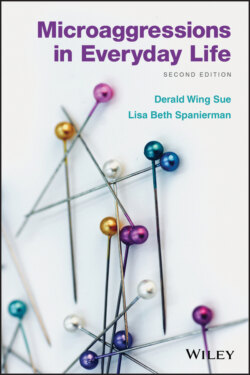Читать книгу Microaggressions in Everyday Life - Derald Wing Sue - Страница 28
The Changing Face of Racism, Sexism, and Heterosexism
ОглавлениеBias, prejudice, and discrimination in North America have undergone a transformation, especially in the post–Civil Rights era when the democratic belief in the equality of marginalized groups (e.g., people of color, White women, and LGBTQ individuals) directly clashes with their long history of oppression in society (Dovidio & Gaertner, 2000; Satcher & Leggett, 2007; Swim, Mallett, & Stangor, 2004). Some scholars refer to color‐blind racism as the dominant racial ideology of the post–Civil Rights era (Neville, Awad, Brooks, Flores, & Bluemel, 2013). The term “color‐blind racial ideology” refers to the belief that race and racism do not matter in society. Color‐blind racism and other subtle and unconscious forms of prejudice have been linked to discriminatory behaviors. More specifically, implicit racial bias has been linked to jury decisions (Lynch & Haney, 2011), police shootings of unarmed Black civilians (Nix, Campbell, Byers, & Alpert, 2015), and physician interactions with patients (Penner, Phelan, Earnshaw, Albrecht, & Dovidio, 2017). Research also indicates that sexism and heterosexism have not decreased but instead have become more ambiguous, making them more difficult to identify and acknowledge (Hylton, 2005; Morrison & Morrison, 2003; Swim & Cohen, 1997). One study, for example, documented that benevolent sexism attitudes were more commonly endorsed than hostile sexism attitudes among male science, technology, engineering, and mathematics (STEM) students; and, accordingly, female STEM students perceived more frequent experiences of benevolent compared to hostile forms of sexism (Kuchynka et al., 2018).
Since the presidential election in 2016, implicit racist views among Americans have become more explicit. We might attribute this phenomenon to Trump's frequent and public expression of racist views (e.g., referring to Mexicans as drug dealers, criminals, and rapists). University of Chicago economist Leonardo Bursztyn (2017) and his colleagues found support for this trend via research on social norms around xenophobia. They found that those with xenophobic views were more willing to express their views publicly after Trump was elected into office. They did not find an increase in xenophobic views among participants. In other words, when a leader publicly states xenophobic views, those views are rendered more publicly acceptable to citizens who hold such views.
While hate crimes and racial, gender, and sexual‐orientation harassment continue to be committed by overt racists, sexists, and heterosexists, perhaps the greatest harm to persons of color, women, and LGBTQ individuals does not come from these conscious perpetrators. It is not the White supremacists, Klansmen, or skinheads, for example, who pose the greatest threat to people of color but rather well‐intentioned people, who are strongly motivated by egalitarian values, who believe in their own morality, and who experience themselves as fair‐minded and decent people who would never consciously discriminate (D. W. Sue, 2005). Because no one is immune from inheriting societal biases, all citizens are exposed to a social conditioning process that imbues within them prejudices, stereotypes, and beliefs that lie outside their level of awareness. On a conscious level, they may endorse egalitarian values, but on an unconscious level, they harbor either pro‐majority feelings (Dovidio et al., 2002) or anti‐minority feelings (D. W. Sue, 2003).
Although much has been written about contemporary forms of discrimination, many studies in health care, education, law, employment, mental health, and social settings (including social media) indicate the difficulty of describing and defining implicit racial, gender, and sexual‐orientation bias; such biases are difficult to identify, quantify, and rectify because of their subtle, nebulous, and unnamed nature (Johnson, 1988; Nadal, Rivera, & Corpus, 2010; Rowe, 1990; Selmi, 2017; D. W. Sue, Nadal, et al., 2008). Subtle racism, sexism, and heterosexism remain relatively invisible and potentially harmful to the well‐being, self‐esteem, and standard of living of members of many marginalized groups in society. Because these “everyday” (Essed, 1991) common experiences of marginalization, hostility, and invalidation tend to be chronic, they may have significantly more influence on anger, frustration, and self‐esteem than overt forms of racism, sexism, and heterosexism (D. W. Sue, Capodilupo, et al., 2007). Furthermore, their invisible nature prevents perpetrators from realizing and confronting their own complicity in creating psychological dilemmas for people of color, women, and LGBTQ persons and their role in creating disparities in employment, health care, and education (Coleman, 2004; Dovidio et al., 2002; Lane, Kang, & Banaji, 2007; Rowe, 1990).
